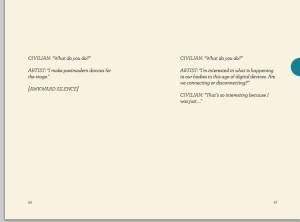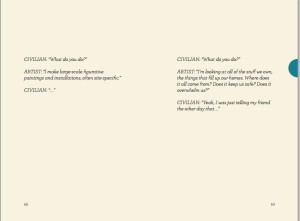You may have seen this recent piece in The New Yorker on creativity. My state arts council linked to it and now I see multiple others have as well.
Author Joshua Rothman asks, “How did creativity transform from a way of being to a way of doing?”
That question gave me pause because in most of the posts I have done on the subject of creativity, it has almost always been about the product of creativity rather than the actual value of the process itself. I frequently invoke (as does Rothman) the IBM survey in which thousands of corporate CEOs said that creativity is one of the things they most highly value. I often talk about how the arts community can show their value to businesses, and by extension, the rest of the world via training and discussion of the creative process.
As Rothman points out, there was a time, (The Romantic period of Coleridge and Woodsworth), when there wasn’t an expectation that what was going on in your head would assume some demonstrable manifestation. (my emphasis)
It sounds bizarre, in some ways, to talk about creativity apart from the creation of a product. But that remoteness and strangeness is actually a measure of how much our sense of creativity has taken on the cast of our market-driven age. We live in a consumer society premised on the idea of self-expression through novelty. We believe that we can find ourselves through the acquisition of new things…Thus the rush, in my pile of creativity books, to reconceive every kind of life style as essentially creative—to argue that you can “unleash your creativity” as an investor, a writer, a chemist, a teacher, an athlete, or a coach. Even as this way of speaking aims to recast work as art, it suggests how much art has been recast as work: it’s now difficult to speak about creativity without also invoking a profession of some kind.
Even before I got to this paragraph near the end of the article, I started to think that we really aren’t allowed to make art for arts sake any more. There is both overt and subtle messaging that if your efforts aren’t advancing your career or marketable skills in some way, then it is frivolous.
It can absolutely be a lot of fun to try something new with the idea that you might be able to integrate it into your work. But how often do we allow ourselves to walk through mountain meadows and imagine making airplanes out of the flowers we see around us? If we allow ourselves to do that, how often is it being used to serve work in the sense of unleashing our creativity Rothman mentions: to surmount a creative block or as a vacation to refresh ourselves to go back to work bright eyed and clear headed?
Given the dynamics of our lives these days, I don’t know that we can ever return to the ideal state of the Romantics Rothman cites. In some sense, as a society we may be better off than the Romantics because more people have the leisure time to indulge their creativity than did in Coleridge’s day.
At the very least, we have the opportunity to open ourselves to fits of fancy and imagination. The exemplar that immediately popped to mind for me was when I was working in Hawaii and had the pleasure of driving Laurie Anderson around. She kept expressing her amazement at how blue the sky was. She may have noticed a dozen other things, but that is what sticks out in my memory. I was so struck by her enthusiasm, that I took her on a detour so I could share the panoramic vista of a scenic overlook with her.

